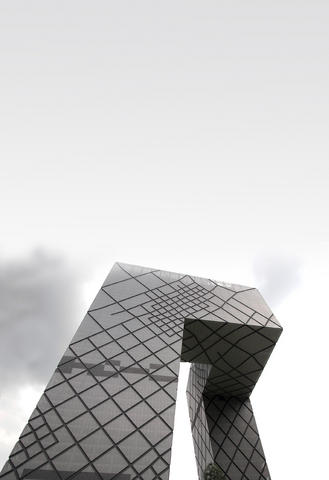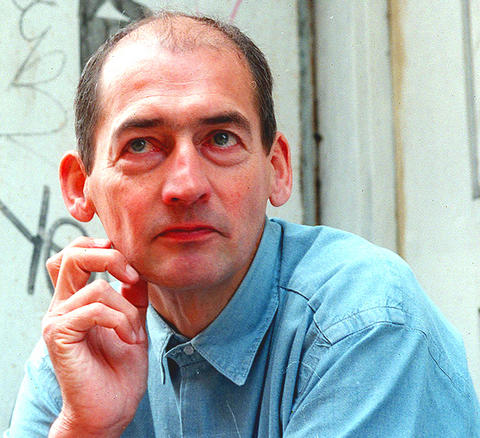Rem Koolhaas has some photographs to show me. Not glossy shots of some earth-shattering new building he has created but small snaps of street life in the age-old courtyards of Beijing. Known as hutongs (胡同), these are tight webs of hodgepodge homes and alleys gathered around wells.
"Most of them will soon be gone," says the architect, speaking in the Rotterdam headquarters of his company, OMA. "The Olympics next year will find them old-fashioned and unsightly. Those who live there are being given new high-rise flats. These are well-equipped and clean, but people, I think, miss their old life down below in the courtyards."
In their place, right in the changing heart of Beijing, no fewer than 300 air-conditioned office blocks and hotels are set to rise. The most dramatic of these hutong-gobblers will be the sensational new headquarters for China Central Television (CCTV), due in time for the Olympics next August, and a world away from the antique courtyards. Its architect? Rem Koolhaas.

PHOTO: NY TIMES NEWS SERVICE
This is exactly the kind of paradox this highly intelligent and self-questioning architect revels in. In public, he is the master of sock-it-to-me design; in private, he looks with affection at the people and places in his photographs, at an old way of oriental life likely to vanish. And even as the heroic structure of the CCTV building, designed with visionary Arup engineer Cecil Balmond, climbs up noisily into the smog of Beijing, Koolhaas is working quietly on the discreet new headquarters for the banking arm of the Rothschild empire in London. You would be hard-pressed to guess that it was from the same hand and eye as CCTV.
The CCTV tower is nothing if not ambitious. Its steel structure forms a continuous spatial loop climbing up and around the volume of the building. Inside, there will be a "media village," complete with places to eat and play, and a sensational public viewing gallery.
And yet, for all this free-thinking design, the one thing CCTV lacks is freedom of expression. Daring new architecture, yes. Radical internal planning, sure. Yet, for all this, CCTV remains a sub-ministry of the government of the People's Republic of China, its news programs controlled by the Propaganda Department.

PHOTO: NY TIMES NEWS SERVICE
Koolhaas may have designed some of the most challenging, controversial and critically acclaimed ultramodern buildings of the past decade - Seattle Public Library, Casa da Musica in Porto, Portugal, the Dutch embassy in Berlin - yet I can't help thinking that, for all the excitement of working with CCTV, his heart belongs to a world closer to Beijing's hutongs.
Koolhaas, born in Rotterdam in 1944, spent four years of his childhood in Jakarta, Indonesia. "The country was newly independent," he says. "I lived as if I was an Indonesian."
Koolhaas' father, Anton, was a distinguished Dutch journalist, novelist and scriptwriter, who became a friend of Sukarno, Indonesia's first president. Somewhere in the young Koolhaas' mind, I can't help thinking, a taste of the exotic was already mixing with a love of writing and of buildings and places that would lead him to work first as journalist, with the Haagse Post, and then as a scriptwriter in the Netherlands and Hollywood, before turning to architecture in 1968. That's quite a resume for any man, let alone one who had just turned 24.

PHOTO: NY TIMES NEWS SERVICE
In 1956, Koolhaas returned to Holland and eventually to his home city, Rotterdam. Anyone born in Rotterdam during and after the second world war might have thought of becoming an architect. From May 14, 1940, the old city all but ceased to exist, after being targeted by 90 German bombers.
"Have you always been designing Rotterdam?" I ask, thinking how it must be hard to ever get the blitzed city out of his mind. He sits up. "You mean because I was first brought up in a city that, in a way, didn't exist?" Yes, so it had to be reinvented. Koolhaas turns his pen over and over: "I know what you mean. We do design a lot of buildings in cities in something like the condition of 1940s Rotterdam: Beijing, where they're pulling down much of the old city; Dubai, a brand new city growing rapidly like a teenager; Abu Dhabi ... . "
He changes tack: "But, with buildings like Seattle and Porto and the embassy in Berlin, no, these belong to settled cities and draw their inspiration from what's around them."
When Koolhaas says "we," he means his OMA practice. This stands for the Office for Metropolitan Architecture, founded in London in 1975. This is also the home of AMO, OMA's research arm. Koolhaas has published fascinating and sometimes contrary reports and books on countless urban subjects since his first, very successful book, Delirious New York, in 1978. At Harvard, where he is a professor, his post-graduate students work up huge reports on Koolhaas's pet subjects, such as the way in which China's Pearl River Delta was becoming one continuous built-up area.
Another report looked at how shopping is fuelling urban growth. So impressed was fashion designer Miuccia Prada with the findings that she commissioned Koolhaas to design stores for her fashion empire in the US. The latest Harvard study focuses on Lagos, a city that intrigues Koolhaas because it is at once venerable and modern, messy and lyrical, rich and poor, energetic and corrupt, but above all alive in a way that his native Rotterdam, a ghost city in August, clearly isn't. "I like Rotterdam," he says. "We work here in a cheap office, out of the way with no distractions. We think for ourselves. We are in some ways outside the architectural loop. We do not follow fashion."
And yet Koolhaas is loved by the fashionable. He is one of those architects who receives star treatment in design magazines. Koolhaas has received pretty much every award going. He roosts at the top of the architectural tree with the likes of Frank Gehry, Zaha Hadid, Daniel Libeskind and Toyo Ito. When he says he hates "celebrity" culture, he almost means it. Koolhaas, though, is nothing if not contradictory. A man who thrives on free thinking, he works happily for absolutist governments. An architect who claims to distrust fashions in design, he is responsible for some of the most eye-catching of all new buildings. Some of OMA's Dubai designs, such as the proposed Ras-al-Khaimah convention and exhibition center, look as if they've been culled from the pages of sci-fi comics; others seem like slab-sided 1960s office towers.
Koolhaas does indeed live at least two lives at once. A tall, wafer-thin man crackling with a quiet energy, he has two homes with two women in two separate cities. In Rotterdam, he shares his life with his partner Petra Blaisse, an interior and garden designer; and, in London, he stays with his wife, the artist Madelon Vriesendorp, with whom he has a son and a daughter, both in their 20s. Just as Koolhaas can love the hutongs of Beijing and design the CCTV tower, it seems he can live a complex personal life.
Because he has been willing to take risks, and because he is unlike most architects, Koolhaas has had his professional ups and downs. When OMA's first major building project, a center for art and media technology in Germany, fell through, Koolhaas worked on his eye-popping book S, M, L, XL, with graphic designer Bruce Mau. Published in 1995, this outlines Koolhaas' belief that the sheer bigness of cities and their buildings today means that the old rules of design, proportion and planning are largely meaningless. "The market economy thrives on spectacle and novelty," says Koolhaas. "Its buildings are ever more dramatic. It offers the promise of total freedom, but in architecture this quickly leads to the danger of grotesqueness. The media, of course, encourages this teenage architecture; it gives most attention to extreme capitalist buildings, to this ever-growing accumulation of architectural extravagance, to fanciful museums full of shops. Perhaps there is still a residual nostalgia for refinement, but the pressure is on the other way."
Only too aware of the absurdities of the bigness of today's cities and their architecture, he nevertheless designs big "iconic" buildings himself, while decrying the practice and researching and designing smaller alternatives. Small wonder that, when I inquire what he plans to do next, he says: "write more." Asked recently to remodel the Hermitage Galleries in St Petersburg, Koolhaas suggested doing as little as possible.
Rem Koolhaas is one of the world's most intriguing architects. Here is an architect who could happily sit down one day with God to design refined and purposeful public buildings knitted into the fabric of old cities, and the next with the devil to design the wayward architecture demanded by ultra-capitalism.

June 9 to June 15 A photo of two men riding trendy high-wheel Penny-Farthing bicycles past a Qing Dynasty gate aptly captures the essence of Taipei in 1897 — a newly colonized city on the cusp of great change. The Japanese began making significant modifications to the cityscape in 1899, tearing down Qing-era structures, widening boulevards and installing Western-style infrastructure and buildings. The photographer, Minosuke Imamura, only spent a year in Taiwan as a cartographer for the governor-general’s office, but he left behind a treasure trove of 130 images showing life at the onset of Japanese rule, spanning July 1897 to

One of the most important gripes that Taiwanese have about the Democratic Progressive Party (DPP) is that it has failed to deliver concretely on higher wages, housing prices and other bread-and-butter issues. The parallel complaint is that the DPP cares only about glamor issues, such as removing markers of Chinese Nationalist Party (KMT) colonialism by renaming them, or what the KMT codes as “de-Sinification.” Once again, as a critical election looms, the DPP is presenting evidence for that charge. The KMT was quick to jump on the recent proposal of the Ministry of the Interior (MOI) to rename roads that symbolize

On the evening of June 1, Control Yuan Secretary-General Lee Chun-yi (李俊俋) apologized and resigned in disgrace. His crime was instructing his driver to use a Control Yuan vehicle to transport his dog to a pet grooming salon. The Control Yuan is the government branch that investigates, audits and impeaches government officials for, among other things, misuse of government funds, so his misuse of a government vehicle was highly inappropriate. If this story were told to anyone living in the golden era of swaggering gangsters, flashy nouveau riche businessmen, and corrupt “black gold” politics of the 1980s and 1990s, they would have laughed.

In an interview posted online by United Daily News (UDN) on May 26, current Chinese Nationalist Party (KMT) Chairman Eric Chu (朱立倫) was asked about Taichung Mayor Lu Shiow-yen (盧秀燕) replacing him as party chair. Though not yet officially running, by the customs of Taiwan politics, Lu has been signalling she is both running for party chair and to be the party’s 2028 presidential candidate. She told an international media outlet that she was considering a run. She also gave a speech in Keelung on national priorities and foreign affairs. For details, see the May 23 edition of this column,